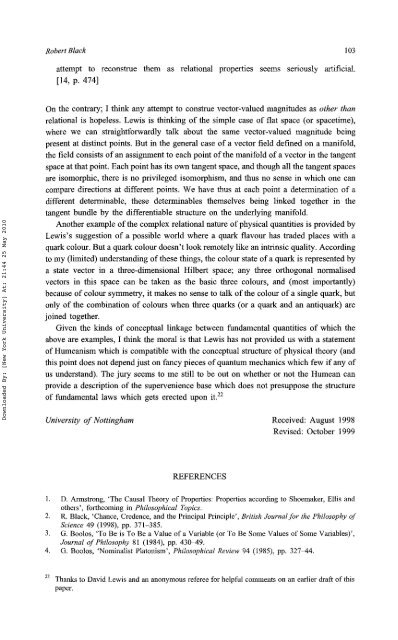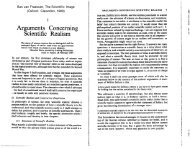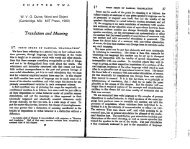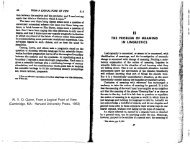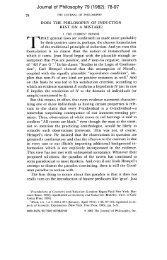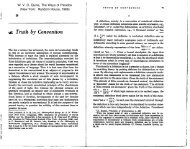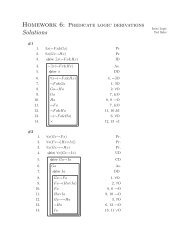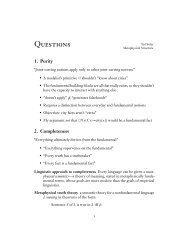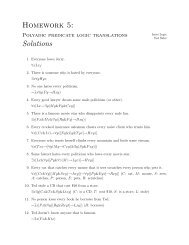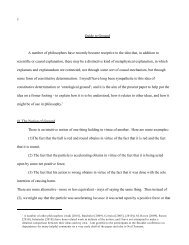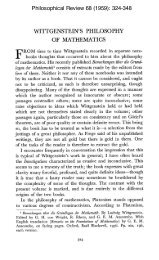Black - against quidditism.pdf - Ted Sider
Black - against quidditism.pdf - Ted Sider
Black - against quidditism.pdf - Ted Sider
Create successful ePaper yourself
Turn your PDF publications into a flip-book with our unique Google optimized e-Paper software.
Downloaded By: [New York University] At: 21:44 25 May 2010<br />
Robert <strong>Black</strong> 103<br />
attempt to reconstrue them as relational properties seems seriously artificial.<br />
[14, p. 474]<br />
On the contrary; I think any attempt to construe vector-valued magnitudes as other than<br />
relational is hopeless. Lewis is thinking of the simple case of flat space (or spacetime),<br />
where we can straightforwardly talk about the same vector-valued magnitude being<br />
present at distinct points. But in the general case of a vector field defined on a manifold,<br />
the field consists of an assignment to each point of the manifold of a vector in the tangent<br />
space at that point. Each point has its own tangent space, and though all the tangent spaces<br />
are isomorphic, there is no privileged isomorphism, and thus no sense in which one can<br />
compare directions at different points. We have thus at each point a determination of a<br />
different determinable, these determinables themselves being linked together in the<br />
tangent bundle by the differentiable structure on the underlying manifold.<br />
Another example of the complex relational nature of physical quantities is provided by<br />
Lewis's suggestion of a possible world where a quark flavour has traded places with a<br />
quark colour. But a quark colour doesn't look remotely like an intrinsic quality. According<br />
to my (limited) understanding of these things, the colour state of a quark is represented by<br />
a state vector in a three-dimensional Hilbert space; any three orthogonal normalised<br />
vectors in this space can be taken as the basic three colours, and (most importantly)<br />
because of colour symmetry, it makes no sense to talk of the colour of a single quark, but<br />
only of the combination of colours when three quarks (or a quark and an antiquark) are<br />
joined together.<br />
Given the kinds of conceptual linkage between fundamental quantities of which the<br />
above are examples, I think the moral is that Lewis has not provided us with a statement<br />
of Humeanism which is compatible with the conceptual structure of physical theory (and<br />
this point does not depend just on fancy pieces of quantum mechanics which few if any of<br />
us understand). The jury seems to me still to be out on whether or not the Humean can<br />
provide a description of the supervenience base which does not presuppose the structure<br />
of fundamental laws which gets erected upon it. 22<br />
University of Nottingham Received: August 1998<br />
Revised: October 1999<br />
REFERENCES<br />
1. D. Armstrong, 'The Causal Theory of Properties: Properties according to Shoemaker, Ellis and<br />
others', forthcoming in Philosophical Topics.<br />
2. R. <strong>Black</strong>, 'Chance, Credence, and the Principal Principle', British Journal for the Philosophy of<br />
Science 49 (1998), pp. 371-385.<br />
3. G. Boolos, 'To Be is To Be a Value of a Variable (or To Be Some Values of Some Variables)',<br />
Journal of Philosophy 81 (1984), pp. 430M9.<br />
4. G. Boolos, 'Nominalist Platonism', Philosophical Review 94 (1985), pp. 327~44.<br />
22 Thanks to David Lewis and an anonymous referee for helpful comments on an earlier draft of this<br />
paper.


